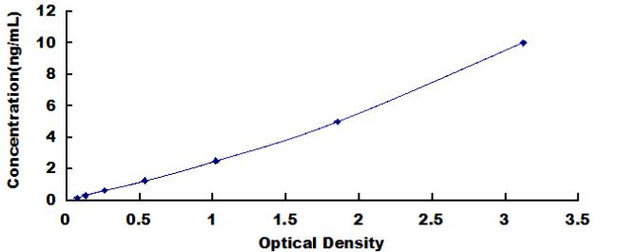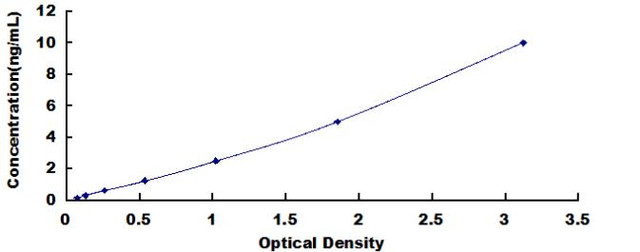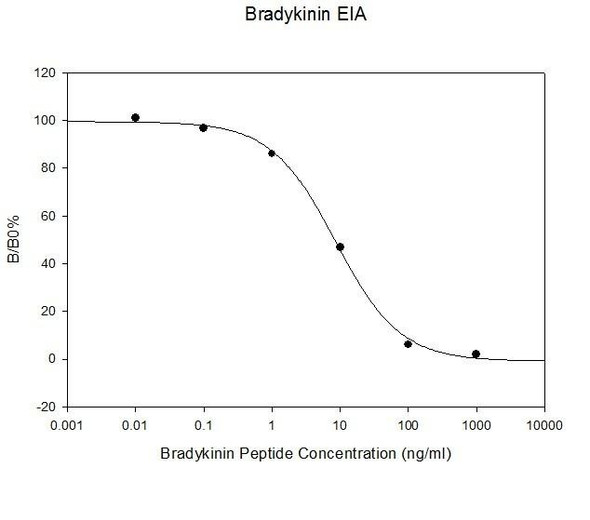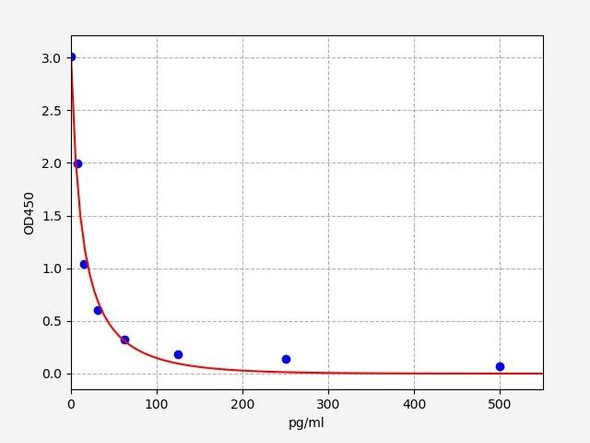Mouse Bradykinin ELISA Kit
- SKU:
- MOFI00669
- Product Type:
- ELISA Kit
- Size:
- 96 Assays
- Uniprot:
- O08677
- Sensitivity:
- 4.688pg/ml
- Range:
- 7.813-500pg/ml
- ELISA Type:
- Competitive
- Synonyms:
- BK
- Reactivity:
- Mouse
- Research Area:
- Developmental Biology
Description
Mouse Bradykinin ELISA Kit
Bradykinin is a small peptide that plays a crucial role in various physiological processes, including inflammation, vasodilation, pain modulation, and immune responses. It is involved in the regulation of blood flow, vascular permeability, and the release of other inflammatory mediators. The Mouse BK ELISA kit enables quantitative measurement of bradykinin levels specifically in mouse samples, allowing researchers to investigate the role of bradykinin in different physiological and pathological conditions.
Key Features
| Save Time | Pre-coated 96 well plate | |
| Quick Start | Kit includes all necessary reagents | |
| Publication Ready | Reproducible and reliable results |
Overview
|
Product Name: |
Mouse Bradykinin ELISA Kit |
|
Product Code: |
MOFI00669 |
|
Size: |
96 Assays |
|
Alias: |
BK |
|
Detection Method: |
Competitive ELISA |
|
Application: |
This immunoassay kit allows for the in vitro quantitative determination of Mouse BK concentrations in serum plasma and other biological fluids. |
|
Sensitivity: |
4.688pg/ml |
|
Range: |
7.813-500pg/ml |
|
Storage: |
4°C for 6 months |
|
Note: |
For Research Use Only |
Additional Information
|
Recovery |
Matrices listed below were spiked with certain level of Mouse BK and the recovery rates were calculated by comparing the measured value to the expected amount of Mouse BK in samples.
|
||||||||||||||||||||
|
Linearity: |
The linearity of the kit was assayed by testing samples spiked with appropriate concentration of Mouse ALT and their serial dilutions. The results were demonstrated by the percentage of calculated concentration to the expected.
|
||||||||||||||||||||
|
CV(%) |
Intra Assay <8 Inter Assay <10 |
Kit Components
| Component | Quantity | Storage |
|
ELISA Microplate (Dismountable) |
8x12 strips |
4°C for 6 months |
|
Lyophilized Standard |
2 |
4°C/ -20°C |
|
Sample/Standard Dlution Buffer |
20ml |
4°C |
|
Biotin-labeled Antibody (Concentrated) |
120ul |
4°C (Protection from light) |
|
Antibody Dilution Buffer |
10ml |
4°C |
|
HRP-Streptavidin Conjugate (SABC) |
120ul |
4°C (Protect from light) |
|
SABC Dilution Buffer |
10ml |
4°C |
|
TMB Substrate |
10ml |
4°C (Protection from light) |
|
Stop Solution |
10ml |
4°C |
|
Wash Buffer (25X) |
30ml |
4°C |
|
Plate Sealer |
5 |
- |
Other materials required:
- Microplate reader with 450 nm wavelength filter
- Multichannel Pipette, Pipette, microcentrifuge tubes and disposable pipette tips
- Incubator
- Deionized or distilled water
- Absorbent paper
- Buffer resevoir
Protocol
*Note: Protocols are specific to each batch/lot. For the correct instructions please follow the protocol included in your kit.
Equilibrate the TMB substrate for at least 30 min at 37°C beforeuse. When diluting samples and reagents, they must be mixed completely andevenly. It is recommended to plot a standard curve for each test.
| Step | Procedure |
|
1. |
Set standard, test sample and control (zero) wells on the pre-coatedplate respectively, and then, record their positions. It isrecommended to measure each standard and sample in duplicate. Washplate 2 times before adding standard, sample and control (zero) wells! |
|
2. |
Add Sample and Biotin-detection antibody: Add 50µL of Standard, Blank or Sample per well. The blankwell is added with Sample Dilution Buffer. Immediately add 50 µL of biotin-labelled antibody workingsolution to each well. Cover with the plate sealer provided. Gently tap the plate to ensure thoroughmixing. Incubate for 45 minutes at 37°C. (Solutions are added to the bottom of micro-ELISA platewell, avoid touching plate walls and foaming). |
|
3. |
Wash: Aspirate each well and wash, repeating the process three timesWash by filling each well with Wash Buffer (approximately 350µL)using a squirt bottle, multi-channel pipette, manifold dispenser orautomated washer. Complete removal of liquid at each step is essentialto good performance. After the last wash, remove any remaining WashBuffer by aspirating or decanting. Invert the plate and pat it againstthick clean absorbent paper. |
|
4. |
HRP-Streptavidin Conjugate(SABC): Add 100µL of SABC workingsolution to each well. Cover with a new Plate sealer. Incubate for30minutes at 37°C. |
|
5. |
Wash: Repeat the aspiration/wash process for five times. |
|
6. |
TMB Substrate: Add 90µL of TMB Substrate to each well. Coverwith a new Plate sealer. Incubate for about 10-20 minutes at 37°C.Protect from light. The reaction time can be shortened or extendedaccording to the actual color change, but not more than 30minutes.When apparent gradient appeared in standard wells, you can terminatethe reaction. |
|
7. |
Stop: Add 50µL of Stop Solution to each well. Color turn toyellow immediately. The adding order of stop solution should be as thesame as the substrate solution. |
|
8. |
OD Measurement: Determine the optical density (OD Value) of each wellat once, using a microplate reader set to 450 nm. You should open themicroplate reader ahead, preheat the instrument, and set the testing parameters. |
Sample Preparation
When carrying out an ELISA assay it is important to prepare your samples in order to achieve the best possible results. Below we have a list of procedures for the preparation of samples for different sample types.
| Sample Type | Protocol |
|
Serum |
If using serum separator tubes, allow samples to clot for 30 minutes at room temperature. Centrifuge for 10 minutes at 1,000x g. Collect the serum fraction and assay promptly or aliquot and store the samples at -80°C. Avoid multiple freeze-thaw cycles. If serum separator tubes are not being used, allow samples to clot overnight at 2-8°C. Centrifuge for 10 minutes at 1,000x g. Remove serum and assay promptly or aliquot and store the samples at -80°C. Avoid multiple freeze-thaw cycles. |
|
Plasma |
Collect plasma using EDTA or heparin as an anticoagulant. Centrifuge samples at 4°C for 15 mins at 1000 × g within 30 mins of collection. Collect the plasma fraction and assay promptly or aliquot and store the samples at -80°C. Avoid multiple freeze-thaw cycles. Note: Over haemolysed samples are not suitable for use with this kit. |
|
Urine & Cerebrospinal Fluid |
Collect the urine (mid-stream) in a sterile container, centrifuge for 20 mins at 2000-3000 rpm. Remove supernatant and assay immediately. If any precipitation is detected, repeat the centrifugation step. A similar protocol can be used for cerebrospinal fluid. |
|
Cell culture supernatant |
Collect the cell culture media by pipette, followed by centrifugation at 4°C for 20 mins at 1500 rpm. Collect the clear supernatant and assay immediately. |
|
Cell lysates |
Solubilize cells in lysis buffer and allow to sit on ice for 30 minutes. Centrifuge tubes at 14,000 x g for 5 minutes to remove insoluble material. Aliquot the supernatant into a new tube and discard the remaining whole cell extract. Quantify total protein concentration using a total protein assay. Assay immediately or aliquot and store at ≤ -20 °C. |
|
Tissue homogenates |
The preparation of tissue homogenates will vary depending upon tissue type. Rinse tissue with 1X PBS to remove excess blood & homogenize in 20ml of 1X PBS (including protease inhibitors) and store overnight at ≤ -20°C. Two freeze-thaw cycles are required to break the cell membranes. To further disrupt the cell membranes you can sonicate the samples. Centrifuge homogenates for 5 mins at 5000xg. Remove the supernatant and assay immediately or aliquot and store at -20°C or -80°C. |
|
Tissue lysates |
Rinse tissue with PBS, cut into 1-2 mm pieces, and homogenize with a tissue homogenizer in PBS. Add an equal volume of RIPA buffer containing protease inhibitors and lyse tissues at room temperature for 30 minutes with gentle agitation. Centrifuge to remove debris. Quantify total protein concentration using a total protein assay. Assay immediately or aliquot and store at ≤ -20 °C |
|
Breast Milk |
Collect milk samples and centrifuge at 10,000 x g for 60 min at 4°C. Aliquot the supernatant and assay. For long term use, store samples at -80°C. Minimize freeze/thaw cycles. |
Bradykinin Background
What is Bradykinin?
Bradykinin is a small peptide involved in various physiological processes within the body. It belongs to a class of compounds known as kinins, which are potent mediators of inflammation and vasodilation. Bradykinin is generated through the enzymatic cleavage of its precursor molecule, kininogen, by enzymes such as kallikreins.
Bradykinin Structure
Structurally, bradykinin is a nonapeptide composed of nine amino acids: Arg-Pro-Pro-Gly-Phe-Ser-Pro-Phe-Arg. The peptide sequence is conserved across different species, including mice and humans. The structure of bradykinin enables it to interact with specific receptors present on the surface of target cells, initiating intracellular signaling cascades.
Bradykinin Function
The main function of Bradykinin is that of a potent vasodilator, meaning it relaxes and widens blood vessels, leading to increased blood flow. It also promotes the release of other mediators involved in inflammation, such as prostaglandins and nitric oxide. Additionally, bradykinin induces pain by sensitizing nerve endings and triggering the release of neuropeptides.
Bradykinin Receptors
Bradykinin Receptors
The mechanism of action of Bradykinin includes binding to two main types of G-protein-coupled receptors: the bradykinin receptor type 1 (B1 receptor) and the bradykinin receptor type 2 (B2 receptor). These receptors are expressed on the surface of various cells throughout the body and are part of the seven transmembrane domained receptor family. They mediate the downstream signaling pathways triggered by bradykinin binding. The Bradykinin receptor type 1 (B1 receptor) in only expressed/upregulated in response to tissue injury or inflmmation, while the Bradykinin receptor type 2 (B2 receptor) s expressed constitutively and is the primary receptor for bradykinin. Both these receptors activate the IP3 DAG pathway and are associated with vasodilation, pro-inflammatory responses, pain transmission and smooth muscle contraction.
Bradykinin Clinical Significance
Excessive or uncontrolled bradykinin production can contribute to pathological processes, such as inflammation, edema (swelling), and pain. In certain diseases, such as hereditary angioedema (C1 esterase inhibitor deficiency), there may be an underlying deficiency or dysfunction in proteins responsible for regulating bradykinin levels, leading to excessive bradykinin release and subsequent symptoms.
Angiotensin-converting enzyme (ACE) is an enzyme that breaks down and inactivates bradykinin. Due to its involvement in vasoconstriction, ACE Inhibitors are often used to control blood pressure. However, as ACE inhibition will lead to sustained bradykinin activation and buildup, causing side effects like angioedema in patients.
Inhibition of ACE, however, also inhibits the inactivation of bradykinin. Because bradykinin is a potent vasodilator, the prevention of bradykinin inactivation causes excessive amounts of bradykinin to build-up. This increased bradykinin can cause the side effect of angioedema
Bradykinin Inhibitors
Bradykinin inhibitors, also known as bradykinin receptor antagonists or bradykinin blockers, are pharmacological agents designed to modulate the effects of bradykinin. These inhibitors can be used to treat conditions characterized by excessive bradykinin activity, including hereditary angioedema and certain forms of angioedema induced by medications like ACE inhibitors. By blocking the interaction of bradykinin with its receptors, these inhibitors help alleviate symptoms associated with bradykinin-mediated processes, such as vascular dilation, inflammation, and pain.
Mouse Bradykinin ELISA Kit FAQs
Q: What is the purpose of the Mouse BK ELISA kit?
A Mouse Bradykinin ELISA Kit is a research tool designed for the quantitative measurement of bradykinin levels in mouse samples.It allows researchers to investigate the role of bradykinin in various physiological and pathological processes. They are valuable tools for studying inflammation, vascular biology, pain modulation, and other related areas of research.
Q: What type of samples can be used with the Mouse BK ELISA kit?
The Mouse BK ELISA Kit can be used with a wide range of sample types, including plasma, serum, tissue lysates, cell culture supernatants, and other biological fluids. The kit usually includes detailed instructions on sample preparation and handling.
Q: Is the Mouse BK ELISA kit compatible with other species?
Mouse Bradykinin ELISA Kits are specifically designed for the measurement of bradykinin in mouse samples. While it is optimized for mouse samples, cross-reactivity with other species has not been tested. For studies involving different species, it is recommended to use ELISA kits specifically designed for those species.
Q: Where can I find additional technical support or assistance with the Mouse BK ELISA kit?
For any technical inquiries or assistance regarding the Mouse BK ELISA kit, you can reach out to our team. They will be available to answer your questions and provide the necessary guidance to ensure a successful experiment.
Related Products

| Mouse Kallikrein 7 (KLK7) ELISA Kit | |
|---|---|
| ELISA TYPE: | Sandwich |
| SENSITIVITY: | 0.056ng/mL |
| RANGE: | 0.156-10ng/mL |

| Mouse C Reactive Protein (CRP) ELISA Kit | |
|---|---|
| ELISA TYPE: | Sandwich |
| SENSITIVITY: | 0.073ng/mL |
| RANGE: | 0.156-10ng/mL |

| Mouse Matrix Metalloproteinase 2 (MMP2) ELISA Kit | |
|---|---|
| ELISA TYPE: | Sandwich |
| SENSITIVITY: | 0.065ng/mL |
| RANGE: | 0.156-10ng/mL |





